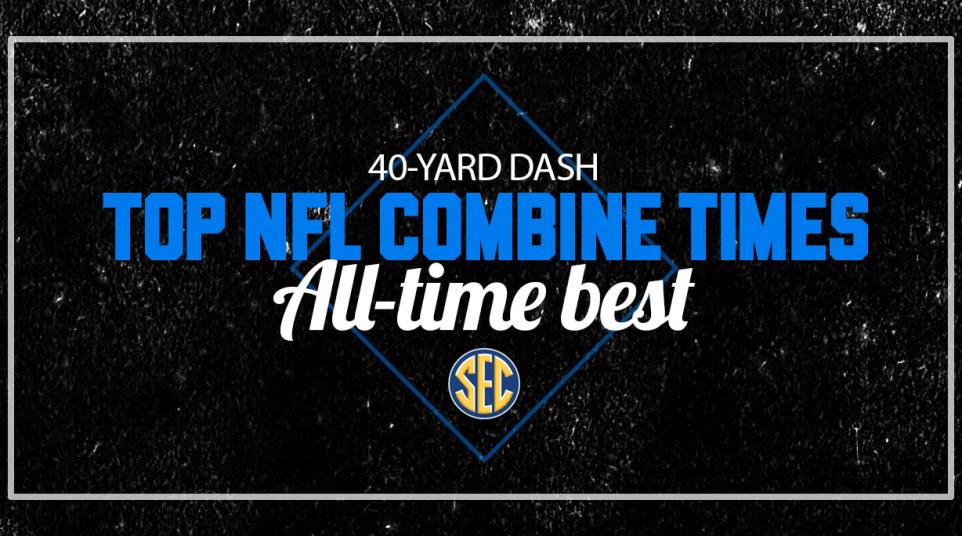
Top SEC 40-yard dash times in NFL Combine history
The 40-yard dash is a curious entity.
In the weeks leading up to the NFL draft, it is touted as a singular data point capable of swinging a player’s rookie contract by as many as seven figures.
Take an informal survey of Division I track athletes and determine how many of them have been asked, at some point or another, “what’s your 40 time?” even though that’s well shorter than the shortest indoor sprint distance.
Once a player reaches the NFL, though, he or she probably will never be tested in a 40-yard dash again. (Exception: If you’re a player like Michael Sam trying to make the league through the bizarre “veteran combine.”)
Even more maddeningly, there are all sorts of issues comparing historical 40 times or trying to estimate, for example, what Usain Bolt could run at the distance.
Every year, scores of football journalists provide inaccurate depictions.
First, the terms “hand-timed” and “electronically-timed” create confusion. At the NFL Combine, three different timing systems have been utilized.
- Until 2000 (according to most reports — others have it changing in 1999), the event relied on hand-timed 40-yard dashes. In other words, a human started and stopped the clock as the runner started and crossed the finish line.
- The second system still required a human to start the clock while watching the player, but an electronic beam at the finish line cut out humans from that part of the equation. “Electronic timing,” though only half electronic, added .175 seconds to every time on average, according to data compiled by Zybek Sports.
- Most recently, the NFL Combine switched to “fully-automated timing” (FAT), with the clock starting electronically when a runner lifts his hand. According to the Zybek Sports data, this method adds an average of .24 seconds.
So, Bo Jackson ran a reported 4.12-second 40-yard dash at the 1986 NFL Combine. Was it the fastest ever? Probably not, but we can’t say for sure. AL.com wrote an excellent piece investigating the issue if you’d like to dive down that wormhole.
East Carolina’s Chris Johnson ran a 4.24 in 2008, which is recognized as the modern record. He often bragged that he could beat Bolt in a sprint and openly hoped for the race around 2010 after a few successful NFL seasons, but it never happened.
A time in the mid-4.1 range — perhaps 4.15 to 4.18 seconds — is what some tentatively estimate that Bolt, the 100-meter dash world record holder, could’ve managed at his peak. FreeLapUSA.com wrote an excellent piece on that estimate if you’d like another wormhole to jump down.
To top it all, NFL.com’s database on the event only dates back to 2006.
So anything claiming to list the best 40-yard dash times in NFL history is a bit of a misnomer.
Also, any time you hear about at a pro day or from most high school players is going to be done by hand, so you can invariably add about two-tenths of a second to it, give or take.
But, just for fun, and so we have some sort of basis for comparison, we’re going to list the top SEC NFL Combine times prior to 2000 and after 2000.
MODERN TIMES (2000-2015)
| PLAYER | TIME | YEAR | TEAM | POS. |
|---|---|---|---|---|
| Jonathan Joseph | 4.31 | 2006 | South Carolina | CB |
| Chris Houston | 4.32 | 2007 | Arkansas | CB |
| Chad Jackson | 4.32 | 2007 | Florida | WR |
| Tim Jennings | 4.32 | 2007 | Georgia | CB |
| Troy Williamson | 4.32 | 2005 | South Carolina | WR |
| Tim Carter | 4.32 | 2002 | Auburn | WR |
| Mike Wallace | 4.33 | 2009 | Ole Miss | WR |
| Darren McFadden | 4.33 | 2008 | Arkansas | RB |
| Ahmad Carroll | 4.34 | 2004 | Arkansas | CB |
| Ryan Swope | 4.34 | 2013 | Texas A&M | WR |
| Onterio McCalebb | 4.34 | 2013 | Auburn | WR |
| Patrick Peterson | 4.34 | 2011 | LSU | CB |
| Trindon Holliday | 4.34 | 2010 | LSU | KR |
| Chris Conley | 4.35 | 2015 | Georgia | WR |
| Laron Landry | 4.35 | 2007 | LSU | S |
| Devin Aromashodu | 4.35 | 2006 | Auburn | WR |
NOTABLE TIMES (PRIOR TO 2000)
| PLAYER | TIME | YEAR | TEAM | POS. |
|---|---|---|---|---|
| Bo Jackson | 4.12 | 1986 | Auburn | RB |
| Champ Bailey | 4.28 | 1999 | Georgia | CB |
| Karsten Bailey | 4.33 | 1999 | Auburn | WR |
